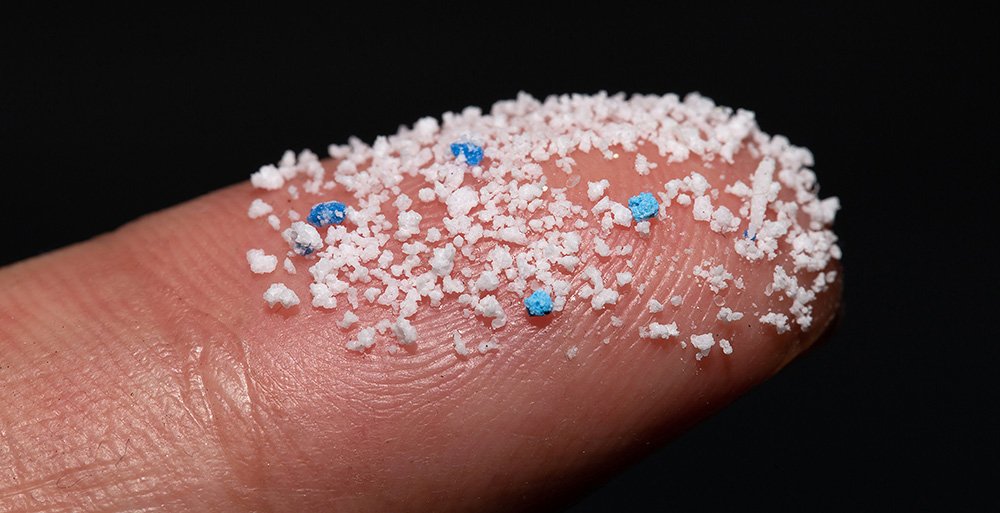Camouflaging crust: When microplastics are exposed to environmental influences, it can more easily penetrate cells, a study has revealed. As a result, deposits form on the surface of the particles, which promote absorption in body cells – like a Trojan horse. It is still unclear what effects this will have on health, because until now researchers have mostly only used fresh, clean microplastics for such studies.
Microplastics are ubiquitous in our environment – whether in the deep sea, our food or even our own organs. According to studies, we ingest more than a hundred of these tiny particles every day, partly through our diet and partly through the air we breathe. Some of them are excreted with the feces, while others accumulate in our tissues. But how does the microplastic get into our body cells? Previous studies have mainly focused on the influence of the size of the particles. But they couldn’t explain the recording exactly.
Environmental influences simulated
A team led by Anja Ramsperger from the University of Bayreuth has now also included environmental influences – the factors to which microplastics are exposed, for example in bodies of water, the ocean or in soils. To simulate a natural environment, the researchers first placed the microplastic particles in fresh water from a pond, salt water from an aquarium or – for control purposes – sterile water for several weeks.
After two and four weeks, they brought this “aged” microplastic into contact with living cells in mice. These were macrophages, i.e. immune cells that patrol the blood, but also occur in large numbers in the intestine. In order to recognize whether the particles were inside the cells or just on their surface, the researchers stained an important part of the structures inside the cell, the actin filaments.
Under the microscope, they could now see which particles were completely surrounded by the stained structures. “The fluorescence marking of the actin filaments made it possible for us to see exactly which particles were taken up by the cells,” explains Ramsperger’s colleague Holger Kress. Using spectroscopic methods, the researchers also demonstrated that it was actually the microplastic and not impurities.
Cover layer made of biomolecules
As Ramsperger and her colleagues found, the microplastics that were exposed to environmental influences were absorbed into the cells about ten times more often than the sterile particles. On the other hand, it made no difference whether the microplastic was previously in salt water or fresh water.
To better understand the mechanisms, the researchers examined the surface of the particles using spectroscopic methods. The result: While the surface of the untouched microplastic was immaculately smooth, numerous deposits of biomolecules had formed on the “aged” particles. “Spectroscopic investigations indicate that the biomolecules are carbohydrates, amino acids, nucleic acids and proteins,” says Ramsperger.
Trojan horse for cell entry
In a natural environment such as the ocean, a lake or even the ground, the first such deposits form after seconds, as the researchers explain. Over time, these initially attached particles are displaced by those with stronger adhesion, which then form a solid crust around the respective particles. In turn, other biomolecules attach to this crust.
Unlike the smooth surface of new microplastic particles, this biological crust offers more opportunities to interact with receptors on the cells. This could facilitate their absorption into the cell interior. “The shell made of biomolecules may act as a kind of Trojan horse that smuggles plastics into living cells,” says Ramsperger’s colleague Christian Laforsch. When the macrophages ingest the microplastic, they serve as a gateway into the various body tissues.
Harmful effects still unclear
However, the consequences of this entry of microplastics into our cells and tissues are still unknown. “Our study supports the assumption that microplastics, which originate from the environment and are therefore coated with biomolecules, not only pass through the digestive tract if they are ingested with food, but can also pass into the tissue,” says Laforsch. “What damage the particles can cause here has not yet been adequately investigated.
It is also unclear which properties of microplastics could be responsible for such potentially harmful effects. However, it is known from studies, for example, that pollutants and bacteria in water and soil preferentially attach to the tiny plastic particles. The extent to which this contributes to negative effects has yet to be researched (Science Advances, 2020; doi: 10.1126 / sciadv.abd1211)
Source: University of Bayreuth
–


